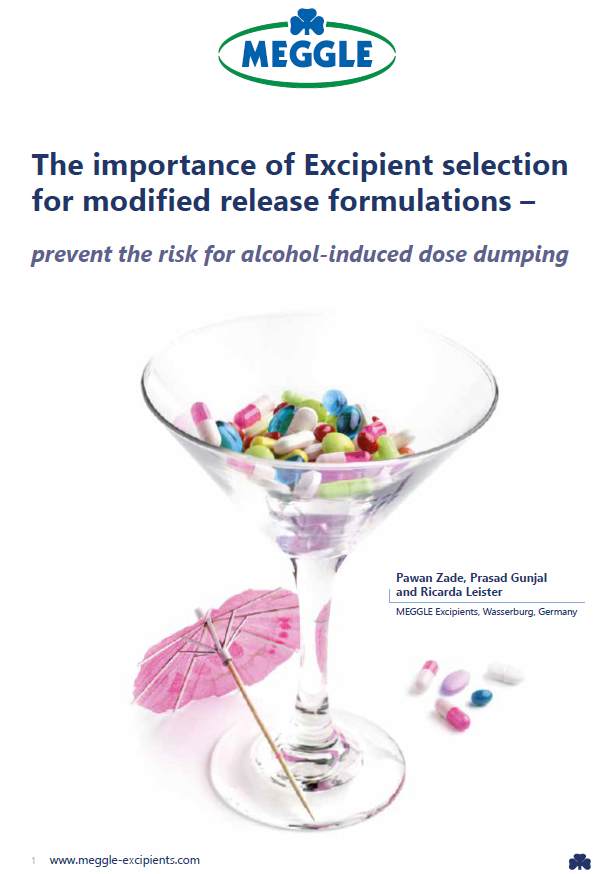Whitepaper | December 2023 | MEGGLE Business Unit Excipients
The importance of Excipient selection for modified release formulations – prevent the risk for alcohol-induced dose dumping
Introduction
The oral route is the main acceptable route, which offers more patient compliance and cost-effective manufacturing processes. Pharmaceutical dosage forms may be developed in which drug release characteristics with respect to time and/or location have in some way been modified compared with conventional dosage forms. These kind of modifications may have several objectives, such as maintaining therapeutic activity for an extended time (better patient compliance), reducing toxic effects, protecting active substances against degradation due to low pH, targeting the active substance to a predefined segment of the gastrointestinal tract for local treatment and product life cycle management for products that are near patent expiry. Thus, modified-release applications continue to be an important development strategy for the global pharmaceutical industry. However, apart from the advantages of modified-release dosage forms, there are numerous challenges in their development. Aqueous solubility, selective stability in the gastrointestinal tract, absorption window of the active ingredients and dose dumping are some of the challenges in the development of modified-release dosage forms.
Dose dumping is a phenomenon in which a relatively large amount of drug is prematurely released due to an environmental factor and introduced into the systemic circulation. The modified-release formulation contains a higher dose of the drug compared to a conventional dosage form. This may lead to an increase in the plasma concentration of the drug above the therapeutic concentration. In the case of potent drugs, which have a narrow therapeutic index, this may be fatal. In general, dose dumping may be induced by concomitant consumption of food and/or alcohol. Food-induced dose dumping has been well recognized for long decades. In 1985, Leslie Hendeles et al. reported that food-induced dose dumping from a once-a-day Theophylline marketed product ‘Theo – 24’ resulted in a Theophylline toxic effect (1).
Alcohol-induced dose dumping (AIDD) occurs when the administration of a medicine with a modified-release formulation is done simultaneously with the ingestion of alcohol. Although there has been research on the impacts of alcohol on oral modified-release dosage forms for more than a decade, the „Palladone case“ in July 2005 brought AIDD to the attention of regulatory authorities (2). After it has been discovered that serious, possibly lethal, adverse reactions can occur when the extended-release Palladone (Hydromorphone hydrochloride) capsules are taken with alcohol, the US Food and Drug Administration has requested the marketing authorization holder to withdraw the capsules from the market (2).
At the lowest marketed dose of Palladone (12 mg), some patients may experience serious or fatal adverse events; the risk is even higher at the highest strength. A 12-mg Palladone capsule co-ingested with 240 mL (8 ounces) of 40% (80 proof) alcohol led to an average peak Hydromorphone concentration that was about six times higher than when taken with water, according to a pharmacokinetic study in healthy subjects. When the drug was taken in combination with 40% alcohol instead of water, one subject noticed a 16-fold increase in plasma concentration. In some subjects, 8 ounces of 4% alcohol, or about two-thirds of a serving of beer, caused a peak plasma Hydromorphone concentration that was nearly twice as high as when the drug was taken with water (2, 3).
If you would like to find out more about this topic, download our white paper free of charge.

